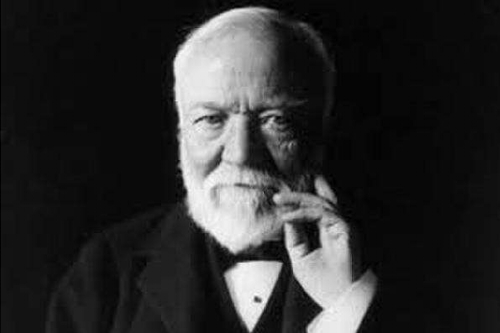How Andrew Carnegie Turned His Fortune into a Library Legacy
图书馆:钢铁大王卡内基的遗产
By Susan Stamberg
文/苏珊·施坦贝格
Andrew Carnegie was once the richest man in the world. Coming as a dirt poor[1] kid from Scotland to the U.S., by the 1880s he’d built an empire in steel – and then gave it all away: $60 million to fund a system of 1,689 public libraries across the country.
安德鲁·卡内基一度是世界上最富有的人。他本是从苏格兰移民美国的一个穷小子,到19世纪80年代便建立起自己的钢铁王国——但后来又把财富全部捐出:6000万美元建立了1689所公共图书馆,形成覆盖全美的公共图书馆体系。
[1] dirt poor〈俚〉极贫困的。
Carnegie donated $300,000 to build Washington, D.C.’s oldest library – a beautiful beaux arts building[2] that dates back to[3] 1903. Inscribed above the doorway are the words: Science, Poetry, History. The building was “dedicated to the diffusion[4] of knowledge.”
卡内基捐赠30万美元,修建起华盛顿特区最早的图书馆——一栋非常漂亮的学院派风格建筑,历史可以追溯到1903年。正门上方铭刻着“科学、诗歌、历史”的字样。整座建筑“专用于知识的传播”。
[2] 学院派建筑。Beaux Arts一词源自法语,意指艺术作品,如今用之命名一种艺术风格:学院派艺术(又称布杂艺术)。该风格源自巴黎高等艺术学院(École des Beaux-Arts)在课堂上教授学生的理念,1885至1920年期间发展并繁荣。塔形建筑群、装饰性壁柱、栏杆、带窗的阳台等都是学院派建筑的特色所在。纽约市公共图书馆(New York Public Library)、纽约中央车站(New York’s Grand Central Terminal)以及波士顿公共图书馆(Boston Public Library)等,都是典型的学院派建筑。此处所说的图书馆指华盛顿特区的卡内基图书馆,据2016年12月的新闻报道,苹果公司准备租赁该楼,建成一个苹果零售店。
[3] date back to追溯至。
[4]diffusion扩散,传播。
It opened in 1903 to women, children, all races—African-Americans remember when it was the only place downtown where they could use the bathrooms. During the Depression[5], D.C.’s Carnegie Library was called “the intellectual breadline[6].” No one had any money, so you went there to feed your brain. Washington writer Paul Dickson, author of The Library in America, says the marble palace was an early and imposing Capitol[7] institution.
“This went in well[8] before the monumental limestone and marble buildings of Pennsylvania Avenue, Constitution Avenue[9]. This was one of the first really beautiful public buildings,” he says.
该图书馆于1903年开始运营,向妇女、儿童和所有种族的人敞开大门——黑人们回忆,在当时的市中心,他们唯一获准使用其中厕所的建筑便是这个图书馆。大萧条期间,华盛顿特区的卡内基图书馆被称为“施舍知识的救济堂”。大家都没钱,所以尽管去卡内基图书馆,给大脑补充营养。华盛顿作家、《美国图书馆》一书的作者保罗·迪克森声称,这座大理石殿堂是国会山一带修建较早的一座建筑,令人印象深刻。
“它比宾夕法尼亚街和宪法街那些气势恢宏的石灰岩和大理石建筑早多了。它属于最早一批修建起来的真正壮观的公共建筑。”他说。
[5] 又称the Great Depression经济大萧条,1929年始于美国股市崩溃,随后席卷全球,一直持续到30年代晚期,是20世纪持续时间最长、影响最为广泛深远的一次经济大萧条。
[6] breadline指排队等待领取救济食品的队伍。on the breadline形容极度贫困的状态。
[7] Capitol= Capitol Hill国会山。它是华盛顿特区的一座山丘,因其山顶有美国国会大厦而常被当作美国国会的别名。卡内基图书馆位于国会山地区,具体位于弗农山(Mt. Vernon)广场附近,与华盛顿会议中心(Walter E. Washington Convention Center)隔广场相望。
[8] well此处是副词,用于介词短语前表示强调,意为“大大地,远远地”。
[9] 宾夕法尼亚街和宪法街是国会山地区的两条街道,有一些重要的历史建筑,如宾夕法尼亚街上的白宫、福特中心等,宪法街的史密斯博物馆、美国国家艺术博物馆等。
Carnegie libraries are still the best buildings in many towns. Over the years some have been expanded or torn down. And, in addition to books and computers, Carnegie libraries find new ways to serve the community.
在许多城镇,卡内基图书馆都仍是当地最好的建筑。随着时间的流逝,有些图书馆扩建了,有些则被拆除了。除了书籍和电脑,卡内基图书馆还找到了新的途径来服务社区。
The public library in Woodbine, Iowa, loans cake pans – people don’t keep all sizes and shapes of cake pans at home, “so they check ’em out and bake their cakes and bring ’em back,” explains Woodbine library director Rita Bantam. “[It’s] offering a service that people need. It brings people into the library.”
艾奥瓦州伍德拜恩市的卡内基公共图书馆出借蛋糕模具,因为普通人家里通常不会买齐所有规格和形状的蛋糕模具,“所以人们可以来借模具,烤完蛋糕之后再还回来。”伍德拜恩图书馆主管丽塔·班塔姆解释说,“这种服务是人们需要的。它会把人们聚到图书馆里来。”

Andrew Carnegie gave $7,500 to Woodbine. That paid for the building itself. The towns had to raise money for books, salaries and maintenance. Before Carnegie, Bantam says, the library was located in an unusual section of Woodbine’s town hall: “It was over the jail,” she explains, “they had to close the library when the jail was occupied.”
安德鲁·卡内基捐给伍德拜恩7500美元。这笔钱用于建造图书馆大楼。伍德拜恩当地市政得筹资购买书籍,支付工作人员工资,并负责图书馆维护。据班塔姆介绍,在卡内基出资之前,该市的图书馆坐落在伍德拜恩市镇厅一个意想不到的角落:“和监狱在一处,”她解释说,“如果监狱来了犯人,图书馆就得关闭。”
From jail to cakepans, public libraries are embedded[10] in their communities. In South Carolina, the Union County Carnegie Library – named best small library in America a few years back – invites Ronald McDonald[11] over to lure kids into summer reading programs. Director Ben Loftis says there were subscription[12] libraries in South Carolina before 1903 when his was built – with a $10,000 Carnegie grant – but this was the first public library.
“It went from being for just the wealthy elite landowners and planters to actually being a service for the entire county that everybody has access to,” he says.
从监狱到蛋糕模具,公共图书馆深深融入了当地社区。在南卡罗来纳州,尤宁县的卡内基图书馆几年前曾荣获全美最佳小型图书馆的称号。该图书馆邀请麦当劳叔叔来到图书馆,以吸引孩子们参加暑期阅读计划。主管本·洛夫蒂斯声称,在卡内基捐款1万美元于1903年建成该图书馆之前,南卡罗来纳有一些收费的会员制图书馆,而该馆是第一座公共图书馆。
“以前那些只面向农场主、种植园主等有钱精英阶层,这个则是真正面向全县公众的,每个人都能来。”他说道。
[10] embed使插入。
[11] 麦当劳叔叔是身穿黄色小丑衣的一个人物形象,是麦当劳快餐连锁店的招牌吉祥物和企业形象代言人,罗纳德·麦当劳是其官方名称。
[12] subscription(俱乐部的)会员费。
…………
Was he the Bill Gates of his day? “I think Bill Gates would very much like to be known as the Carnegie of his day,” says Nasaw.
他是他那个时代的比尔·盖茨吗?“我倒觉得比尔·盖茨会很愿意别人称他为这个时代的卡内基。”纳莎说道。
In 1889 Carnegie wrote an article called “The Gospel of Wealth,” in which he spelled out his views on philanthropy: “In bestowing charity the main consideration should be to help those who help themselves.”
1889年,卡内基写了一篇题为“财富的福音”的文章,阐明了他对慈善事业的看法:“在决定慈善捐赠的时候,主要的考虑应该是帮助那些自助的人。”
The rich should give, so the poor could improve their own lives – and thus the lives of the society. Giving was a code of honor. “The man who dies rich dies in disgrace,” Carnegie said.
富人应该给予,以便穷人能够改善自己的生活——并从而提高全社会的生活质量。给予是荣誉的准则。“一个有钱人如果到死还是很有钱,那就是一件可耻的事情。”卡内基说。
…………








